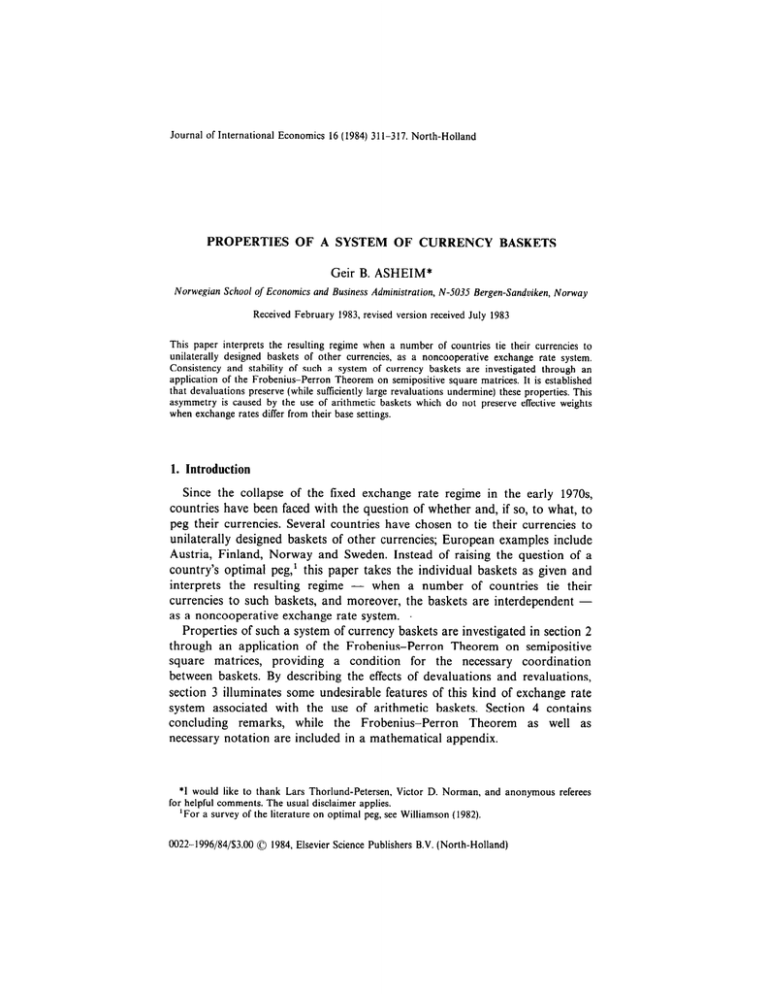Geir B. ASHEIM* PROPERTIES OF A SYSTEM
advertisement

Journal of International Economics PROPERTIES 16 (1984) 311-317. OF A SYSTEM North-Holland OF CURRENCY BASKETS Geir B. ASHEIM* Norwegian School of Economics Received and February Business Administration, 1983, revised N-5035 version received Bergen-Sanduiken, Norway July 1983 This paper interprets the resulting regime when a number of countries tie their currencies to unilaterally designed baskets of other currencies, as a noncooperative exchange rate system. Consistency and stability of such a system of currency baskets are investigated through an application of the Frobenius-Perron Theorem on semipositive square matrices. It is established that devaluations preserve (while sufficiently large revaluations undermine) these properties. This asymmetry is caused by the use of arithmetic baskets which do not preserve effective weights when exchange rates differ from their base settings. 1. Introduction Since the collapse of the fixed exchange rate regime in the early 197Os, countries have been faced with the question of whether and, if so, to what, to peg their currencies. Several countries have chosen to tie their currencies to unilaterally designed baskets of other currencies; European examples include Austria, Finland, Norway and Sweden. Instead of raising the question of a country’s optimal peg,’ this paper takes the individual baskets as given and interprets the resulting regime - when a number of countries tie their currencies to such baskets, and moreover, the baskets are interdependent as a noncooperative exchange rate system. Properties of such a system of currency baskets are investigated in section 2 through an application of the Frobenius-Perron Theorem on semipositive square matrices, providing a condition for the necessary coordination between baskets. By describing the effects of devaluations and revaluations, section 3 illuminates some undesirable features of this kind of exchange rate system associated with the use of arithmetic baskets. Section 4 contains Theorem as well as concluding remarks, while the Frobenius-Perron necessary notation are included in a mathematical appendix. *I would like to thank Lars Thorlund-Petersen, Victor D. Norman, for helpful comments. The usual disclaimer applies. ‘For a survey of the literature on optimal peg, see Williamson (1982). 0022-1996/84/$3.00 0 1984, Elsevier Science Publishers B.V. (North-Holland) and anonymous referees 312 G.B. Asheim, Properties of a system of currency baskets 2. Consistency and stability When a country (country i) ties its currency to a basket of n- 1 other currencies, it selects a positive base exchange rate vector ey =(ey,, . . . , e:“), eFi = 1, in terms of its own currency, and assigns non-negative2 nominal weights Wij to country j’s currency (Cj wij = 1 and wii =O). Country i adjusts the supply of its currency so that the observed positive current exchange rate vector ei =(ei i, . . . , ei,), e,, = 1, in terms of its own currency, satisfies cj Wijt?ij/eyj = 1.3 W e assume that the country’s central bank is perfectly able so to peg its currency, provided that a certain consistency requirement (to be discussed below) is fulfilled.4 If countries 1,. . ,m, where m <n, adopt this mechanism, the resulting linear system of m equations is called a system of currency baskets. Countries 1, . . . , m will be referred to as the m member countries; countries m+ 1,. . . , n as the n-m nonmember countries. Let x=(x,,. . .,x,) be a relative exchange rate vector, with CjXj = 1. Assuming perfect arbitrage between the m currency markets, every member country observes the same x; this unique x is equal to ei/Cj eij for any i. The system of currency baskets can thus be represented by 4x, + 4,x,, = XI, (1) where A,=[aij](i,i=l ,..., m) and A,,=[aij](i=l ,..., m;j=m+l,..., n) are both semipositive matrices whose elements are defined by aij = wi j/eyj, and where x,=(x ,,..., x,) and x,,=(x,+i ,..., x,). We will require the coefficient matrix A, to be indecomposable so that no subsystem is self-contained (see the appendix). We define a system of currency baskets to be consistent if, for any given relative exchange rates between nonmember currencies, there exists a unique positive vector x* satisfying (1) and cj xj* = 1. The following proposition gives a sufficient and necessary condition for consistency. Proposition 1. A system of currency baskets characterized by the indecomposablecoefficient matrix A, is consistent if and only if the FrobeniusPerron root of A,, L(A,), is smaller than one. Proof. If I(A,)<l, then x,=(Z-A,)-‘A,,x,,>O by (1) and lemma 5 in the appendix; i.e. the relative exchange rates between nonmember currencies uniquely determine all relative exchange rates. G xj* = 1 insures a unique x*. *For mathematical convenience we choose to limit ourselves to non-negative weights, even though negative weights to some currencies is a theoretical possibility that appears to have policy relevance; see Williamson (1982, p. 43). ‘This kind of arithmetic index is currently used to indicate the external value of the Finnish markka, the Norwegian krone and the Swedish krona. %t practice, most basket peggers intervene only when the basket deviates by some percentage from I. G.B. Asheim, Properties of a system of currency baskets 313 If x* exists, then (I - A,)x: = A,,xfi 20 by (1), and lemma 4 in the appendix implies A(&) < 1. Remark. The condition productiveness condition ,I(A,)< 1 is mathematically that applies to a, Leontief equivalent to the system with input coefficient matrix A,. The condition on A, that secures the consistency of a system of currency baskets also implies that the new solution vector x*, in the wake of altered relative exchange rates between nonmember countries, can be reached through an iterative process, without any coordination between member countries other than a common choice of a nonmember currency as numeraire.’ Let x’=(x~,x~,) be the relative exchange rate vector at time t, with cj xf = 1. Furthermore, let y’=(yi, y,,) be the exchange rate vector at time t in terms of the common numeraire, with y’ =x1/x: (n is the chosen numeraire currency), and where y,, is constant for any given relative exchange rates between nonmember currencies. Assume that every member country determines its desired exchange rate in terms of this particular numeraire at time t on the basis of observed exchange rates at time t - 1, i.e. 4Yf - 1 + AMY,, =yl. (2) Then we may define a system of currency baskets to be stable if the sequence by (2) approaches the unique positive (YP, y:, . . ’ 7Y; - I, YL . *. ) determined vector y:, with y*=(y:,y,,) satisfying (1) and Cj yT= l/x,*, for any initial vector yp. Proposition 2. Any consistent system of currency baskets is stable. Note that yf=(Z-AA,)-‘A,,y,,, by (l), and y;=(c;ZA Ai)A,,y,,+A;yF, by (2). The proposition follows from lemma 5 in the appendix. Proof: The last proposition of this section shows that restrictions on base exchange rates provide a sufficient condition for the consistency and stability of a system of currency baskets. Base exchange rates among the m member countries are called internally consistent if there exists a positive vector xp = (xy, . . . , xz) satisfying xi” = eyj/CT= 1 eFk,j = 1,. . . , m, for any i. Proposition 3. A system of currency baskets is consistent and stable v the base exchange rates among its membersare internally consistent. 5An obvious real-world candidate is the U.S. $. As the argument below goes through also when a composite of nonmember currencies is used as numeraire, the 1981 definition of the SDR is a relevant alternative. 314 G.B. Asheim, Properties of a system ojcurrency baskets recalling that I;= i wij = 1 and eyi = 1. Since A,, 2 0, there exists some i for which cj=,,,+i wi j > 0. Hence, (1-,4,)x: 2 0, and the proposition follows from lemma 4 in the appendix and propositions 1 and 2. Remark. Internal proposition consistency of base exchange rates is sufficient to establish 3, but not sufticient to insure x:/x: = x:/xj’. Internal consistency clearly holds if member countries choose base exchange rates equal to observed exchange rates at the same point in time. Some thought should make it clear that adoption of baskets at different points in time still produces a consistent and stable system even though base exchange rates become internally inconsistent.6 However, as will be shown in the next section, subsequent devaluations or revaluations also make base exchange rates internally inconsistent and may undermine the consistency and stability of the system. 3. Devaluations and revaluations, Country i devalues (revalues) by proportionally increasing (decreasing) all decreases (increases) its elements of ep, save eFi( = l),‘,s i.e. it proportionally row of coefficients in A=(A,,A,,). Hence, a devaluation (revaluation) is achieved by premultiplying A by a diagonal matrix D, where the devaluing (revaluing) country’s diagonal element is positive and smaller (greater) than one, and where all other diagonal elements are equal to one. If any one country devalues (revalues), the other m- 1 member countries will have their currencies appreciated (depreciated) in terms of the devaluing (revaluing) country’s currency. This effect will, however, be cancelled out by a depreciation (appreciation) of their currencies in terms of the n-m nonmember currencies. The other member countries will in effect pass on the consequences of a devaluation or revaluation to the nonmember countries. It follows that a devaluation (revaluation) by any one country is not equivalent to a revaluation (devaluation) by the m- 1 other member countries. Hence, ‘Provided that ep=ei when a nonmember country i adopts a basket and becomes a member, the solution vector x* will not change. ‘It might be argued that also efi be changed proportionally so that internal consistency of base exchange rates is preserved. However, this undermines the proof of proposition 3. ‘Norway applies this procedure [see Norges Bank (1982)]. Sweden and Finland adjust the target for & wi,eij/efj (currently being 1.32 in Sweden and in the range 1.219-1.275 in Finland). The effect on the coefficient matrix A, is identical. G.B. Asheim, Properties o/a system of currency baskets 315 the effects on the consistency and stability of the system of a devaluation by a member country is not symmetric to the effects of a simultaneous revaluation by the other member countries. This asymmetry is captured by the following proposition. Proposition 4. Any devaluation preserves the consistency and stability of a system of currency baskets. A revaluation may undermine the consistency and stability of such a system. DI I implies DA,< A,. Hence, I(DA,) <,I(A,) < 1 by lemma 3 in the appendix, where l(DA,) is the Frobenius-Perron root of DA,. The first part of the proposition also follows trivially from lemma 4 in the appendix. The second part of the proposition is most easily shown by assuming that all m countries revalue simultaneously. If no diagonal element of D is smaller than W,) - ‘, it follows from lemma 3 in the appendix that 1(DA,)z 1 since Proof: DA, 2 AJI1(A,). Remark. Returning to the Leontief system analogy, a revaluation is mathematically equivalent to increased input coefficients. This clearly reduces the productiveness of a Leontief system. Proposition 4 is not meant to indicate that inconsistency and unstability of a system of currency baskets is an empirical possibility. For the interdependence between currencies in existing noncooperative exchange rate systems is much too weak. Rather, it illuminates an undesirable feature associated with the use of arithmetic baskets when current exchange rates differ greatly from their base settings, namely that effective weights (aijxj*/$) will deviate from their nominal values (wij). When one member country devalues, all member currencies depreciate in terms of nonmember currencies. Hence, the effective weights on nonmember currencies will increase and, on balance, the effective weights on other member currencies will decrease since effective weights sum to one. Should another devaluation occur, the member countries will therefore, on balance, insufficiently depreciate their currencies in terms of nonmember currencies.’ Inversely, revaluations, on balance, increase the effective weights on other member currencies and induce member countries to overreact, excessively appreciating their currencies in terms of nonmember currencies. This excessive response may theoretically undermine the consistency and stability of a noncooperative exchange rate system. The deviation between effective and nominal weights can be eliminated by using geometric indices to indicate the external value of member currencies. 9This may explain why Finland devalued its currency following the Swedish devaluation on 8 October 1982, even though the Swedish krona is represented in the Finnish basket. 316 G.B. Asheim, Properties of a system of currency baskets Country i then adjusts the supply of its currency so that e, =(ei,,. . .,e,“) satisfies xi wij In (eij/eyj) =O. There may be several reasons why the arithmetic basket is still preferred empirically: it is more easily calculated and, being a fixed combination of currencies, it has most of the properties that individual currencies have. lo Finally, it should be noted that the case in which there is only one nonmember currency (m= n - 1) is a roundabout description of a fixed exchange rate system, since all relative exchange rates are uniquely determined given the m baskets. The system consisting of all n countries may then be considered a cooperative exchange rate system, where the nth country ‘coordinates’ agreed upon devaluations (revaluations) by the other n- 1 countries. Proposition 4 points to the fact that a simultaneous finite revaluation by the n- 1 countries may lead to an infinite appreciation of their currencies in terms of the nth currency. ‘Coordination’ by the nth country thus becomes impossible since the exchange rate of its currency is driven down to zero. If we want the size of devaluations (revaluations) - as conveyed through the devaluation (revaluation) matrix D - to correspond to the resulting change in relative exchange rates, this can be achieved by not only premultiplying A=(&&) by D but also postmultiplying DA, by D-‘, since effective weights can be shown to be preserved through such an operation.’ ’ 4. Concluding remarks We have shown that a system of currency baskets is consistent and stable under a wide set of circumstances, including the situation where base exchange rates among the member countries are internally consistent. Moreover, the consistency and stability are preserved whenever countries within such a noncooperative exchange rate system devalue, while sufficiently large revaluations undermine these properties. This asymmetry is caused by the use of arithmetic baskets which do not preserve effective weights when exchange rates differ from their base settings. Finally, the condition securing consistency and stability of a system of currency baskets is mathematically equivalent to the productiveness condition that applies to Leontief systems. Appendix A vector x or a matrix A is positive (> 0) if all its elements are positive, non-negative (20) if all its elements are non-negative, and semipositiue ( 20) if “For SDR. “This ecu. the latter point, see Polak’s is in some sense what (1979) the EMS arguments intends in favour to do through of an arithmetic adjusting basket the composition for the of the G.B. Asheim, Properties of a system of currency 317 baskets its elements are non-negative, but not all zero. Notation for inequalities between vectors or matrices is analogous. A semipositive square matrix A is called indecomposable (or irreducible) if there exists no permutation of like rows and columns for which A may be written in the form A, I 4, ---L---[0jAt,, 1' with square matrices A, and indecomposable matrix. Then: A,,, on Lemma I. The matrix A has a dominant simple, real, and positive. the diagonal. characteristic Let A be an root J(A) which is Lemma 2. The characteristic vector x* associated with J(A) is positive. Lemma 3. A(A) increases when any element of A increases. Lemma 4. A(A)< 1. There exists a positive vector x such that (I - A)x 2 0 if and only if Lemma5. (l-A)-’ existsand equals~~=,A’>Oifand onlyifA(A)<l Lemmas 1, 2, and 3 are a restatement of the Frobenius-Perron Theorem which is proved in numerous references, e.g. Debreu and Herstein (1953). A(A) is often called the Frobenius-Perron root. Lemmas 4 and 5 are well established in the economic literature and are referred to as conditions securing productiveness (or workability and profitability) of a Leontief system with input coefficient matrix A [see, for example, Nikaido (1968, pp. 87108)]. References Debreu, G. and I.N. Herstein, 1953, Nonnegative square matrices, Econometrica 21, 597-607. Nikaido, H., 1968, Convex structures and economic theory (Academic Press, New York). Norges Bank, 1982, Economic survey, Economic Bulletin 53, 167-185. Polak, J.J., 1979, The SDR as a basket of currencies, IMF Staff Papers 26, 627-653. Williamson, J., 1982, A survey of the literature on the optimal peg, Journal of Development Economics 11, 39-61.





